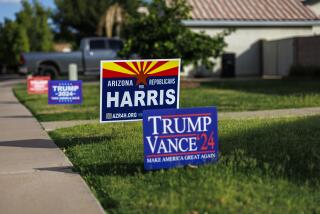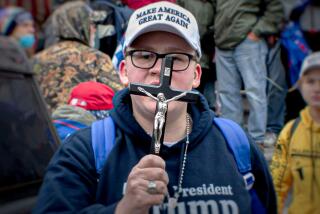RELIGION / JOHN DART : March for Jesus Seems to Achieve Its Goal of Remaining Nonpolitical
- Share via
With 14 pastors and several thousand participants, the event had little of the right-wing rhetoric usually heard at such gatherings.
When theologically and culturally conservative Christians gather publicly for shows of strength, invigorated by songs and prayers with a touch of martial rhetoric, it is rare that abortion, homosexuality and the perceived sins of liberal politicians go unmentioned.
But it would appear that the goal of a “nonpolitical” March for Jesus this past week in Santa Clarita was basically achieved.
Not bad for a rally that had 14 pastors taking turns with prayers and a march that attracted about 3,500 participants (a number provided by organizer Cathy Love). Police estimated at the time that the crowd was between 2,000 and 5,000. Large Jesus rallies of the past 20 years have been characteristically God-and-country gatherings with a discernible right-wing flavor.
The closest thing to a political dig in Santa Clarita was probably when one pastor prayed that President Clinton and Vice President Gore would “come to the Lord” and lead the country according to Christian beliefs.
In fact, Clinton and Gore are both churchgoing Southern Baptists, and whether they were really believers was hardly a campaign issue. Nevertheless, their religious practice has been little comfort in conservative circles where the term “liberal Christian” is thought to be an oxymoron.
For example, the annual meeting of Southern Baptists this week in Houston overwhelmingly adopted a resolution to “separate” the nation’s largest non-Catholic denomination from Clinton’s policies on abortion and homosexual rights and “urge him to affirm biblical morality” in public office. A proposed amendment calling on the President to “repent” his positions was defeated.
It has been clear that the new strongly conservative leadership of the Southern Baptist Convention is unhappy with Clinton in the White House. The moderate leadership of the Southern Baptists in the 1970s, for instance, rejoiced in having Jimmy Carter, one of their own, in the presidency. Carter was routinely invited to speak to the annual meetings as were Presidents Ronald Reagan and George Bush, both non-Baptists. Clinton was not invited this year.
In Santa Clarita, the Rev. Mike Valdez, an assistant pastor at HavenHouse Foursquare Church, explained in an interview this week why he prayed for Clinton and Gore “to come to the Lord.”
Choosing his words carefully, Valdez said it was not a political issue for him.
“I was simply praying for the reality of the package of God’s salvation that includes God’s grace, God’s mercy and submission to his rulership according to his written word for all men.”
The context for his prayer, he said, was 1 Timothy 2:1, which he quoted from the New American Bible: “First of all, then, I urged that entreaties and prayers, petitions and thanksgiving be made on behalf of all men, for kings and all who are in authority, in order that we may lead a tranquil and quiet life in all godliness and dignity. This is good and acceptable in the sight of God our Savior, who desires all men to be saved and to come to the knowledge of the truth.”
Although Valdez’s prayer may have implied that Clinton and Gore still needed saving, several other pastors who spoke at the event said they didn’t recall that Valdez’s words were judgmental.
A Lutheran minister in Canyon Country who said he helped pray over Clinton more than once at gubernatorial inaugurations in Little Rock, Ark., said that he was not offended by the prayer reference to Clinton and Gore.
“I took it as a prayer for the leaders of our country,” said the Rev. Duane Brunette, pastor of the Bethlehem Lutheran Church.
Pastor Ken Teel of Lily of the Valley Christian Center said that he personally feels that Clinton “is not protecting biblical and family values in his political capacity. But where he is spiritually, we don’t know. Only God knows.”
The Rev. Craig Miller, pastor of Faith Community Evangelical Free Church, said he was pleased that speakers stuck to “proclaiming our allegiance to the Lord Jesus Christ rather than promoting an agenda that comes from that commitment.”
Most assessments of the March for Jesus praised the event as the largest one ever to bring together so many conservative churches of various denominations.
Mainline Protestant and Catholic churches, along with Jewish and other non-Christian religious groups, tend to gravitate toward the Interfaith Council of Santa Clarita Valley and its activities. Nevertheless, one of the 14 clergy who led prayers after the march was Father Dan Fox, associate pastor of St. Clare Catholic Church in Canyon Country.
And the Rev. Keith Davis, pastor of Desert Streams Church of the Open Bible, said that he has worked seven years to establish his congregation and had not done anything in concert with other Valley ministers before.
“I sensed a strong sense of cooperation and excitement,” he said.
As many as 40 churches promised to send people to join the march, but Love said that the number actually represented was probably around 25.
The march was one of 350 around the country on the same day, coordinated by a group based in Austin, Tex. That state, with 32 marches, and California, with 31, topped the list. The 24,000 who showed up in San Diego made that march the fourth largest in the country, a national spokesman said.
The 15-member national advisory board for March for Jesus U.S.A. includes two San Fernando Valley residents--the Rev. Jack Hayford of The Church on the Way in Van Nuys, and John Dawson, author and chairman of Youth With a Mission. Along with C. Peter Wagner of Pasadena’s Fuller Theological Seminary, the three are leading exponents of religious theories that concerted prayers by large numbers of believers can thwart so-called territorial demons causing trouble in metropolitan areas.
The key figure is British songwriter Graham Kendrick, whose book suggesting such marches led to the international movement.
“As the world of ‘not yet’ believers look on, they see the radiance on our faces, the reflected glory of the One on whom we are all gazing,” he wrote. “They hear our joyful praises and pick up the song we are singing.”
Marchers are required to sing the same songs of praise at every parade--at least nine of them, all composed by Kendrick and copyrighted by his Make Way Music.
Participants in the Santa Clarita parade said that there were few people watching along the parade route.
“The purpose was not to have an audience but (to have) participants,” said Pastor Miller.
On the night after the rally, a vandal scrawled graffiti on the walls of a Mormon church building near the parade route. Slogans such as “Down with religion,” “There’s no Christ” and “Devil is the Power” indicated to police and Mormon church authorities that the vandal was reacting to the rally because of the lack of any anti-Mormon messages, according to Jack Adams, a regional public affairs director for the Mormon Church.
March organizer Cathy Love volunteered to send someone to help with the cleanup, “which was very nice, but it was written in charcoal and we already had water-sprayed it off,” said a Mormon spokesman.
Love, a homemaker with three children, said, “Overall, people were very pleased with how the march went.” She said clergy and churchgoers were looking forward to next year’s march, set for June 25 around the world.
More to Read
Sign up for Essential California
The most important California stories and recommendations in your inbox every morning.
You may occasionally receive promotional content from the Los Angeles Times.










